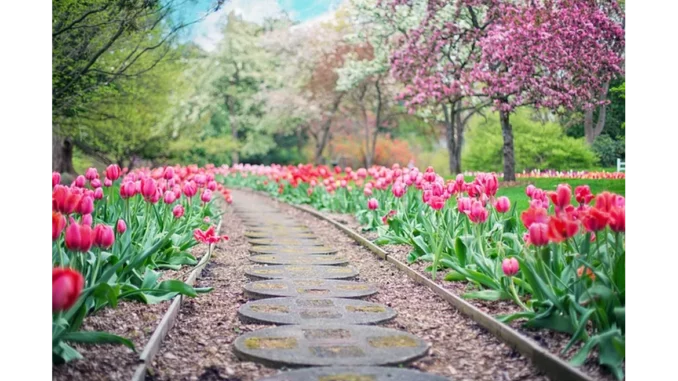
When I sat down with Emma Kinsley, a landscape architect who played a pivotal role in transforming challenging garden spaces, I was eager to delve into her recent feature in Ideal Home UK Magazine. Emma’s journey into garden design has been nothing short of inspiring, and her expertise in creating stunning landscapes on sloping sites has garnered quite the attention, including an impressive 731 likes and 10 comments on her latest social media post. Her collaboration with the magazine offered an invaluable opportunity to share her knowledge with a wider audience, and she was more than willing to recount her experiences for our readers.
Emma welcomed me into her sunlit studio, a place brimming with sketches, plant samples, and an array of garden tools. Her passion for her craft was evident from the moment we began our conversation.
The Challenge of Sloping Sites
“Designing a garden on a sloping site is like solving a beautiful puzzle,” Emma began, her eyes lighting up with enthusiasm. “Each site is unique, and the challenge lies in working with the natural contours rather than against them.”
Emma explained that one of the most crucial steps in designing such gardens is conducting a thorough site analysis. This includes understanding the soil composition, the direction of the slope, drainage patterns, and sunlight exposure. “You can’t just impose a design onto a sloping site; you need to let the landscape guide you,” she emphasised.
Incorporating Terracing and Retaining Walls
One of the key techniques Emma discussed was the use of terracing and retaining walls. “These elements are essential for creating usable, flat spaces on a slope,” she said. Emma highlighted the importance of selecting the right materials for these structures to ensure both functionality and aesthetic appeal. Natural stone, timber, and brick are popular choices, each offering distinct visual and structural benefits.
“Terracing not only maximises the usable space but also adds an element of depth and interest to the garden,” Emma noted. “It allows for different levels of planting, which can create a more dynamic and visually appealing landscape.”
Plant Selection and Soil Management
Emma’s advice on plant selection was particularly insightful. “When designing a garden on a slope, it’s important to choose plants that can thrive in that environment,” she explained. Deep-rooted plants are ideal for stabilising the soil and preventing erosion, while ground covers can help retain moisture and reduce weed growth.
She also stressed the importance of soil management. “Sloping sites often have issues with drainage, so it’s crucial to improve the soil structure with organic matter and ensure proper irrigation systems are in place,” Emma advised. Her approach involves a balance of native and ornamental plants to create a resilient and sustainable garden.
Creating Pathways and Access Points
Another significant aspect of Emma’s designs is the incorporation of pathways and access points. “Accessibility is key in any garden design, but it becomes even more critical on a sloping site,” she explained. Thoughtfully designed paths can guide visitors through the garden safely and comfortably, while steps and ramps can provide access to different levels.
Emma shared some practical tips for creating pathways. “Use materials that provide good traction, like gravel or textured pavers, and ensure the paths are wide enough for easy navigation,” she suggested. “Incorporating gentle curves can also make the path feel more natural and inviting.”
Personal Touches and Client Collaboration
Emma’s favourite part of any project is adding personal touches that reflect the client’s personality and lifestyle. “Every garden should be a reflection of the people who use it,” she said with a smile. She recalled a recent project where she incorporated a client’s love for Mediterranean plants and rustic materials into a sloping garden design, resulting in a serene and welcoming space.
“Collaboration with clients is crucial,” Emma added. “Their input and vision are invaluable in creating a garden that truly feels like their own.” She encourages her clients to share their ideas, preferences, and even concerns throughout the design process, ensuring the final result is a harmonious blend of professional expertise and personal taste.
The Joy of Seeing a Garden Come to Life
As our conversation came to a close, Emma reflected on the joy she finds in her work. “There’s nothing quite like seeing a garden come to life,” she said softly. “Watching the plants grow, the seasons change, and knowing that you’ve created a space where people can relax, connect with nature, and make memories—it’s incredibly rewarding.”
Emma’s collaboration with Ideal Home UK Magazine provided a platform to share her valuable insights and inspire others facing similar design challenges. Her dedication to her craft and her ability to turn complex projects into beautiful, functional spaces are truly commendable.
For anyone looking to embark on the journey of designing a garden on a sloping site, Emma’s advice is clear: embrace the natural contours, choose the right plants and materials, and always keep the client’s vision at the heart of the project. With these principles in mind, even the most challenging landscapes can be transformed into stunning outdoor sanctuaries.
Sarah Berryman


Be the first to comment